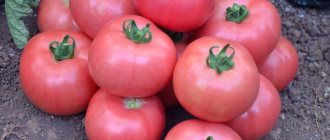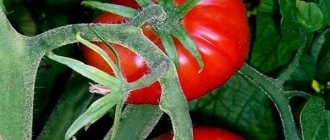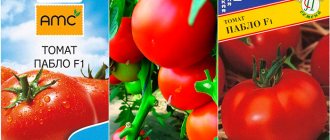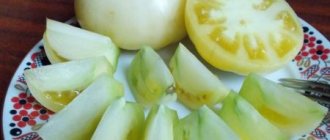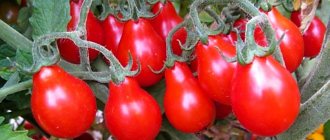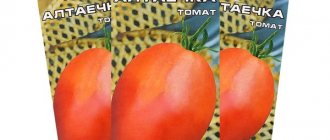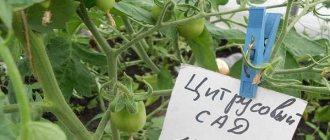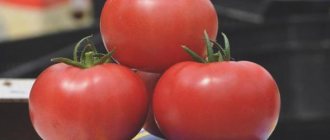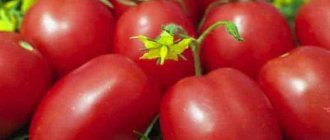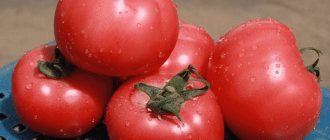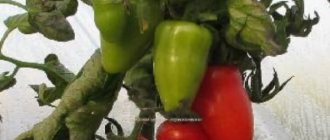Tomato Druzhok F1 is a hybrid that will appeal to farmers and gardeners who value productivity, unpretentiousness, and taste. The variety was bred by Sortsevovoshch breeders.
| Height | Landing location | Ripening time | Fruit color | Fruit size | Origin | Fruit shape |
| Medium height | Greenhouse, Open ground | Early ripening | Reds | Average | Hybrid | Flat-round |
Description
Hybrid Druzhok F1 is determinate, medium-sized. The height of the bush does not exceed 50-70 cm. The tops are compact and thick-trunked, which makes them strong.
The first brush from the fruit is formed above the 6th leaf, the rest - after 2-3 leaves. Each bunch produces 6 to 8 tomatoes.
Distinctive features
The peculiarity of the hybrid lies in its unpretentiousness to growing conditions. Due to this, the fruits ripen in any weather. After the tomatoes form on the inflorescence of the main stem, the plant enters the active growth phase. This is not typical for the group of determinate tomatoes.
Reference. To increase productivity, it is recommended to tie the bushes to a support.
When growing tomatoes in greenhouses or tunnels under film without additional heating, the bush forms 2-3 stems. They are obtained from stepsons that grow in the axils of the leaves located under the first inflorescence. Thanks to this, 3-4 inflorescences appear on each stem.
Fruit characteristics and yield
The hybrid variety Druzhok is an early ripening tomato. After germination and before harvesting, an average of 85-90 days pass. The tomato is universal, the fruits ripen almost simultaneously. Tomatoes are harvested in 1-2 times, which is convenient if the main part goes for processing or marketing. Product germination rate is 90%. A view of a ripe Druzhok tomato is shown in the photo above.
High level productivity – 8-10 kg per 1 m². The hybrid is resistant to transportation and long-term storage without loss of external and taste qualities. The variety is unpretentious and can withstand temperature fluctuations and exposure to direct sunlight. The plant responds well to fertilization and watering.
Fruit characteristics:
- Tomato has a distinct red color.
- The shape of the tomato is flat-round.
- Average weight is 110-115 g.
- With improved care, the weight of the fetus reaches 150-200 g.
- The tomato tastes sweet, fleshy, dense.
- The seeds are in 2-4 nests.
- When processed into juice, the dry matter is not less than 5%, sugar - 4%.
Tomatoes are suitable for fresh consumption, canning and processing. The hybrid is characterized by an attractive appearance, therefore it is in particular demand among gardeners and traders.
Description of the Ugazher tomato and recommendations for breeding the hybrid
The Uhazher tomato belongs to the group of compact-sized hybrids. Therefore, it can be grown in a city apartment using a loggia or balcony. The seeds of this variety are produced by the company Sedek. The hybrid, which has many fans, bears fruit well in greenhouses and open ground. The grown fruits are quite large in size. The skin of the Suitor has increased resistance to cracking. This allows you to store the crop for a long time or transport the berries over long distances.
- 1 Some information about the plant
- 2 How to grow the described tomato?
Some information about the plant
The characteristics and description of the variety are as follows:
- The first fruits appear 110-115 days after transplanting the seedlings onto permanent soil.
- The bush of the described variety rises in height by 0.8-1.0 m. An average number of leaves, colored in dark shades of green, grow on the stem.
- The first inflorescence appears above the 7th leaf, and subsequent similar elements develop through 2 leaves.
- The stalk has no articulations. There are no color spots on it.
- The fruits are cylindrical in shape with a smooth surface. The weight of the berries reaches 0.11-0.12 kg. Inside them there are 2 or 4 seed chambers. Ripe fruits are red in color, while unripe berries are green.
Many reviews are left by those farmers who grew this tomato variety. Gardeners indicate that Uhazher tomatoes need to eliminate stepsons, but at the same time they resist various diseases well. The Uhazher's yield is approaching 6 kg of fruit from 1 m² of bed.
Those people who planted the hybrid in their personal backyards claim that the tomato can withstand sudden changes in weather conditions. But it is better not to experiment with this property of the hybrid, otherwise you may lose the entire harvest.
The hybrid is successfully cultivated throughout Russia. It grows well in open ground in the southern regions of the country. Farmers in the middle zone use film greenhouses to grow this tomato. In the northern regions, it is recommended to plant Uhazher in greenhouses with good heating.
The hybrid is used for canning and pickling. Tomato paste, ketchup, juices, and sauces are made from it. You can eat Ujazher fresh or prepare salads.
How to grow the described tomato?
Even a novice gardener can grow a good harvest if he follows all the recommendations of experts. Any deviation from the rules will result in a loss of 30 to 50% of the crop.
To get strong shoots, the seeds are sown in the first ten days of March, placed in containers with special tomato soil to a depth of 15-20 mm. Then the crops are sprayed with warm water and the boxes are covered with film.
In order for the seedlings to germinate within a week, it is recommended to maintain a room temperature of +21...+25°C. After the sprouts sprout, the container with the tomato is transferred under special lamps, providing maximum illumination to the young plants. Seedlings need to be watered regularly. Fertilizing is carried out with organic mixtures, for example, peat and manure.
The sprouts are transplanted to permanent soil in mid-April. Before this, the bushes are hardened for 7-10 days. The soil must first be loosened and nitrogen fertilizers introduced into it. Uhazher is planted according to the 0.5x0.5 m pattern. The formation of a bush is carried out from 3-4 stems. Sometimes it is necessary to tie the stem to a support.
Subsequent fertilizing with potassium and phosphorus fertilizers is carried out after the development of the ovary, then when the fruit appears.
Watering is carried out as needed, when the soil under the bushes is completely dry. The procedure is carried out with warm water in the evening or early in the morning. There is no need to moisten the soil too much, otherwise the roots will begin to rot. It is recommended to promptly weed the beds to remove weeds and carry out loosening to ensure an influx of oxygen to the tomato root system.
To prevent the development of various diseases, it is recommended to treat the leaves and trunks of plants with medications that destroy fungi and various bacteria.
The threat of crop destruction by garden pests can be eliminated if preventive measures are taken against them, for example, treating the leaves on the bushes with a soap solution. If this does not help, then the extermination of aphids, Colorado potato beetles and other insects is carried out with chemical toxic substances, which can be purchased in specialized stores.
To destroy parasites entrenched on tomato roots and slugs, it is recommended to treat the soil under each plant with ash flour.
How to grow seedlings
According to the description on the package, the seeds are sown from April 1 to April 15. If landing is planned at the end of May or beginning of June, the dates are shifted to April 15-30.
Seed preparation
To protect the plant from fungal diseases and increase the percentage of germination, the seeds are treated with a solution of potassium permanganate and water before sowing (1 g of manganese is diluted in 100 ml of water at room temperature).
The result should be a dark liquid with a thick consistency - the key to high-quality disinfection. The seeds are placed in it for 25 minutes. If the packaging indicates that the material has already been processed, this step can be skipped.
Attention! Before planting seeds, you need to check their quality - soak for 30 minutes. Floated specimens are not suitable for planting. It is also important to look at the expiration date on the packaging.
Next, the planting material is washed with running water and dried with a paper towel. You can use a growth stimulator. A piece of gauze is moistened in the solution, the seeds are placed in it, placed in a plate or other container and left warm for 24 hours. The following products are suitable for this: “Epin”, “Kornevin”, “Silk”, “Zircon” or sodium humate.
Container and soil
It is recommended to plant seedlings in special containers, which are purchased at agricultural markets or in stores where seeds are sold. You can also make them yourself. The container should be wide, but shallow. Plant seedlings into pots whose volume does not exceed 300 ml. The photo below shows suitable containers.
Soil for seeds is made from humus and black soil. To make the composition softer, it is recommended to add additional sand, sawdust, and fine coconut fiber. Additionally, you can include ash and Fitosporin in the composition. If you plan to buy a ready-made mixture, it is better to choose one adapted for tomatoes and peppers.
Advice. Experienced gardeners advise beginners to use soil from a greenhouse so that the tomatoes, after planting in the soil, take root faster and easier.
The soil from the street, even though it is in a covered place, can contain many pests. To get rid of them, disinfection is carried out. To do this, the soil is calcined in the oven, poured with boiling water or doused with an aqueous solution of potassium permanganate. It is enough to wait 30 minutes.
Sowing
After preparing the soil, make holes or grooves in it no more than 1-2 cm deep at a distance of 2 cm from each other. The seeds are placed in the resulting depressions. They are sprinkled with earth on top, but not compacted. It is recommended to moisten the soil with warm water using a spray bottle.
To speed up germination, containers are covered with film or glass. Be sure to place the seedlings in a warm room. Optimal temperature control is within 23-25°C. In such conditions, the seeds will begin to germinate after 3-5 days.
Growing and care
After the first shoots appear, make sure that the temperature during the day is 16-18°C, and at night – no more than 13-15°C. The seedlings remain in this mode until 2-3 true leaves appear (after about 30-35 days). During the entire period, seedlings should be watered 2-3 times so that they do not stretch out during the low light season.
Every day, turn the container with seeds the other side towards the window so that the stems do not tilt. It is not recommended to water seedlings frequently. Make sure that water does not get on the foliage. The seeds are in the boxes without fertilizer. After 2-3 true leaves appear, the seedlings are planted in pots measuring 8x8 cm and left for about 20-25 more.
How to grow tomatoes
For the hybrid tomato Druzhok F1, soil is especially important. If it has a high concentration of clay, it is recommended for each square. m of land add 1 bucket of peat, humus or sawdust.
If the composition contains more peat, then humus, turf, sawdust or sand are added.
Landing
It is recommended to plant plants in a permanent place at the age of 30-35 days. Often this period occurs at the end of May or beginning of June, so it is better to place the tomato in greenhouse conditions.
If planting is done directly in open ground, the seeds are sown 2 weeks later than the recommended date. This way you can be sure that the air temperature will be stable at the time of transplantation.
It is recommended to first disinfect the soil with a hot solution of potassium permanganate (1 g of manganese per 10 liters of water). Place the sprouts at a distance of 40-50 cm from each other in one row. Many gardeners advise planting tomatoes in a checkerboard pattern.
Care
To get a good harvest, the Druzhok tomato must be watered correctly and regularly. A ratio of 85-90% soil moisture under the bush and 50% air humidity is considered favorable. After planting in the ground, the seedlings need to be well watered at the root and left for 2-3 days. After this, moisturizing is repeated 1-2 times a week.
Important! During the formation of inflorescences, the plant must receive magnesium.
Fertilizing is done once every 2-3 weeks, and it is important to alternate organic and mineral fertilizers. It is recommended to combine loosening the soil between rows with weeding.
The depth of loosening during the first 2-3 weeks after planting is no more than 12 cm. When the bush grows, additional hilling is carried out (the first - 2-3 weeks after planting, subsequent ones - at intervals of 15 days).
Features of cultivation and possible difficulties
In the review of the Druzhok F1 tomato, it is necessary to touch upon the topic of possible difficulties and characteristics of cultivation.
Experienced agronomists recommend:
- feed young seedlings with liquid fertilizers;
- treat the roots with strengthening solutions before planting in the ground;
- carefully select seeds and seedlings before planting, do not waste time on weak plants;
- use drip irrigation or apply water in doses to each bush;
- mulch the soil with straw, hay or freshly cut grass.
As for possible difficulties, the Druzhok hybrid is considered an unpretentious variety of tomatoes. If all planting and care rules are followed, you can count on good seed germination and high yield.
Diseases and pests
The main goal of breeding a hybrid was to save the agronomist from unnecessary hassle. Therefore, a characteristic feature of Druzhka is its high resistance to diseases and pests.
The stem and leaves contain a large amount of alkaloids that repel natural enemies of the nightshade family.
As a preventative measure, it is recommended to regularly inspect the bushes. Additionally, spraying with a solution of laundry soap (dilute 1 tbsp. grated product per 10 liters of water) will protect the plants.
Tomato Kokhava F1 - description and characteristics of the variety
Tomato Kokhava F1 belongs to the indeterminate varieties. Zebroid is very popular among gardeners due to its early ripening and unpretentiousness.
Intelligence has high yield rates. The plant is very productive; with proper care and favorable climatic conditions, the harvest can be harvested until late autumn.
The multi-chambered nature of the fruit makes it juicy for processing into juice.
The stems of the plant are powerful, thick, the foliage is dark green, the root structure is fibrous and well developed. Bushes can reach 2 m or more and require staking. The fruits are very tasty, with thick, elastic skin, slightly flattened complexion, and when ripe they acquire a light pink tint.
Adult transplants have strong roots and are resistant to a wide variety of diseases. The bush has a dense foliage cover of a dark green color. Volumetric brushes with 6-8 tomatoes are formed on top of the plants. The hybrid is tolerant to late blight. It would be a good idea to carry out preventative measures to avoid the spread of pests. For this purpose, the bush is treated with a weak solution of potassium permanganate.
On average, the weight of the fruit is 200. Kokhava buttocks are quite popular due to the long shelf life of the fruit and their resistance to transportation.
The crop mixture must be produced when the fruits are at technical maturity. The disadvantage of this variety is that, due to the size of the tomatoes, it is impossible to preserve whole tomatoes. The eggs do not crack due to their thick skin, which prevents tomatoes from falling apart during heat treatment.
Growing up and retirement
The seeds are disinfected, soaked and planted in boxes with fertile soil. Greenhouse conditions are created for young seedlings, covering them with film or glass. Shoots appear in 6-8 days. Tomatoes are illiterate and afraid of replanting. In the phase of formation of three leaves, plants dive into (to avoid strengthening the root system.
The Kokhava hybrid is grown primarily indoors. An important aspect in caring for this crop is irrigation. It should be plentiful and timely. During drought, the autochoir must be watered every day.
Tall bushes are watered right to the root. The soil around the plantings is mulched with straw. It is forbidden to water the plants with cold water over the leaves, otherwise there is a risk of sunburn. It is also necessary to repeat the weeding and loosening procedures more often.
Soil Wotan of the difficult questions that gardeners and gardeners face when growing tomatoes: how and with what to fertilize the soil? Some people have heard enough about the boundless fertility of black soils and for years do not give the land any fertility, others are afraid of being poisoned by nitrates and also try to get by without taking into account the addition of nutrients, others, having read enough advertising, want to steal it only by adding humisol, humate and other laudatory preparations. Although, when starting to work on the land, you should remember the well-known oar of the farmer: everything taken from the land must be redeemed for it
It is clear that the tomato crop, for which the gardener works from spring to autumn, will be confiscated
Although, when starting to work on the land, you should remember the well-known oar of the farmer: everything taken from the land must be redeemed for it. It is clear that the tomato crop, for which the gardener works from spring to autumn, will be confiscated.
But there is a lot of waste left. The energy contained in them must under no circumstances be removed from the circulation of the garden plot and must be returned to the earth.
However, this waste must be properly cooked before being added by composting it.
It is recommended to lay compost heaps in the summer, but it is often better to do this in late August - early September.
In the garden, it is not forbidden to have a box in which all garden and vegetable waste is stored. Rotted waste and compost are added to the holes when planting tomato seedlings. It's not a sin to add wood ash.
When placing components in a compost pit, they are sprinkled with superphosphate, urea, and ammonium sulfate.
Irrigation
Lack of moisture negatively affects the fruiting of tomatoes. The end of June, July and August are the time of the hottest and driest days, the era of growth of the bulk of the harvest. Plants at this time need intensive watering. After the watering procedure, the soil is loosened and mulched.
The beds where butts are grown should be filled with humus. In summer you need to regularly water, loosen and feed the plants. The Kokhava hybrid is popular due to the long shelf life of the fruits and their resistance to transportation.
The nuances of growing in open ground and in a greenhouse
The hybrid is classified as determinant, so its growth stops after the formation of 3-4 inflorescences. If tomatoes are grown in a greenhouse, it is better to form one stem.
Reference. When forming the hybrid Druzhok F1 into one stem, it is allowed to increase the planting density by 25-30%.
After 3-4 inflorescences appear, it is necessary to pinch the growing point. Each stepson is pinched after the formation of 3-4 brushes. Thanks to this, all the energy will be spent on the formation and growth of the fruits of the main stem. Shoots are removed until they reach the top of the greenhouse or maximum growth.
If the tomato is planted directly in open ground, then it is better to form 3 stems. This is done according to the above scheme (growth points are pinched). To make the side stems powerful, stepsons of leaves are left under the first inflorescence. As a result of these actions, a bush up to 1 m high with 3-4 inflorescences on each stem is obtained.
Description of the tomato variety Druzhok and its characteristics
Tomato “Druzhok F1” is an original hybrid from a Russian breeding plant, which received the best reviews for its unpretentiousness and productivity. It produces excellent harvests even for beginners in vegetable growing.
Description of the hybrid
Description of the variety: the bushes of the hybrid “Druzhok F1” are determinate, grow up to 50-70 cm. The growing season lasts about 90-100 days. The stem is strong and standard. Tomatoes grow better if tied to a support or trellis.
Tomatoes “Druzhok F1” are resistant to sunlight, the foliage protects the fruit from burns. Clusters form six or eight fruits. In total, the bush bears 3-4 fruitful clusters on one stem. Productivity reaches 12-16 kg of tomatoes per 1 square meter with good care, as well as proper agricultural technology.
Characteristics of the fruits: the fruits of “Druzhok F1” are medium, tasty, sweet and sour. The plant produces many beautiful red standard fruits of 80-100 grams each. The shape of the fruit of the variety is round, leveled with a small depression at the bottom. The tomatoes are fleshy, juicy, the skin is thick and tender. All “friends” mature almost simultaneously.
Advantages of the hybrid “Friend F1”
Reviews and product qualities of the hybrid are excellent:
- good taste;
- productivity;
- attractive appearance of the variety;
- fruits of standard size;
- friendly ripening of fruits;
- The fruits are shelf-stable, do not wrinkle or crack during transportation or on the bush.
The combination of these qualities of the variety makes it attractive for vegetable growers to grow Druzhok F1 tomatoes both for themselves and for sale. These tomatoes are in demand on the market.
Red tomatoes contain the natural antioxidant lycopene, which destroys cancer cells and prolongs youth.
Tomatoes have a great effect on the functioning of the heart and vascular system, and also improve the functioning of the liver, kidneys, and pancreas. Such tomatoes are very useful, both raw and thermally processed. During heat treatment, the amount of vitamin C in tomatoes almost doubles.
How to increase productivity
The yield of Druzhok F1 tomatoes can be increased by following certain growing rules:
- You need to fertilize the seedlings once a week with liquid fertilizers for seedlings of vegetable plants.
- During transplantation, it is necessary to use preparations to strengthen the root system, as well as ash, which is used to powder the holes.
- Before planting seedlings, they must be carefully inspected. Weakened or broken plants should be thrown away.
- Tomato bushes are planted according to the scheme: 80-100 cm between rows, 40-50 cm between bushes.
- It is best to water tomatoes by drip.
- After planting the bushes of the variety, it is necessary to water the tomatoes every 10-12 days.
- It is better to mulch the soil under the plant with finely chopped grass, hay or straw.
- First, fertilize with a nitrogen formula, then with potassium fertilizers according to the scheme.
Tomato disease resistance
“Druzhok F1” tomatoes are disease-resistant hybrids, so they practically don’t get sick, and you don’t have to worry about the harvest.
To increase productivity and obtain harvests of this variety earlier than stated by the manufacturer, you can use preparations with vegetable growth accelerators. For example, the modern biostimulant “Biogrow” (for description and dosage, see the instructions for the drug).
Farmer reviews
Reviews from professional and novice gardeners about the Druzhok F1 tomato are mostly positive.
Elena, Krasnodar: “Last year I planted this hybrid for the first time. I'm happy with the result, but initially I needed to get acquainted with the intricacies of stem formation. Now I’ll think in advance about the best place to plant tomatoes and prepare places for tying them up. The only thing that upsets me is the impossibility of preparing seeds on my own.”
Olga, Voronezh: “I grew this tomato in pots that are in my gazebo. After the formation of three stems, I noticed that the bush turned out to be very spreading, and at the same time it looked quite nice. The tomatoes are delicious, even small children liked them. This year I will plant again and recommend it to everyone.”
